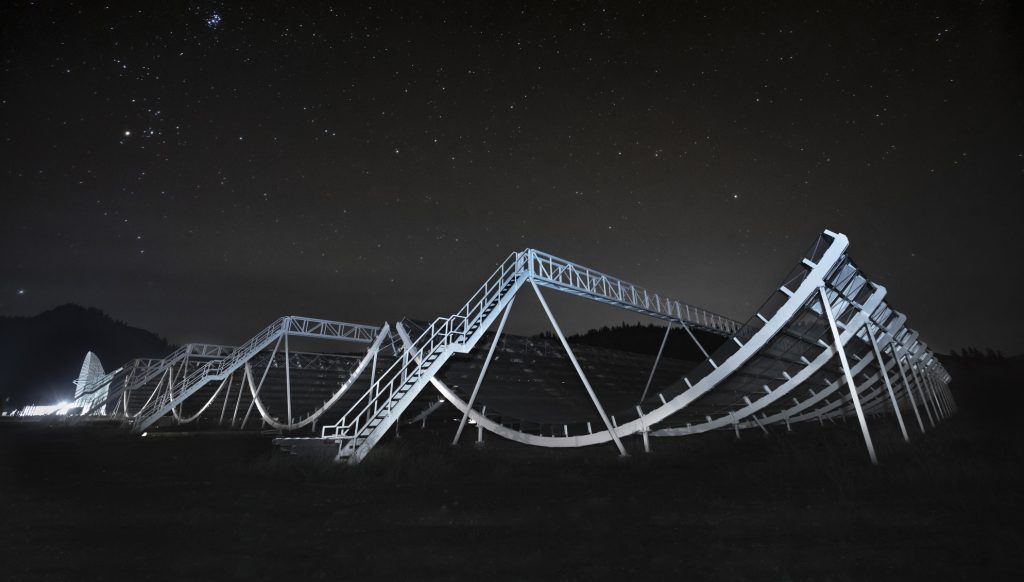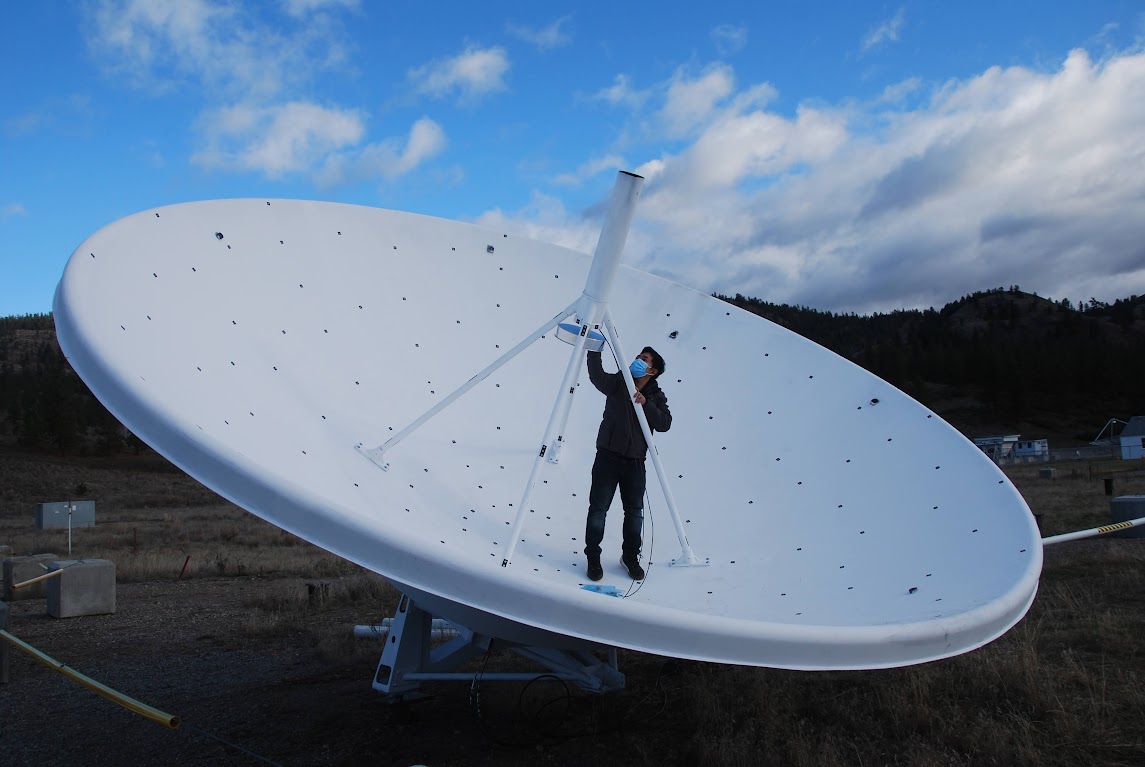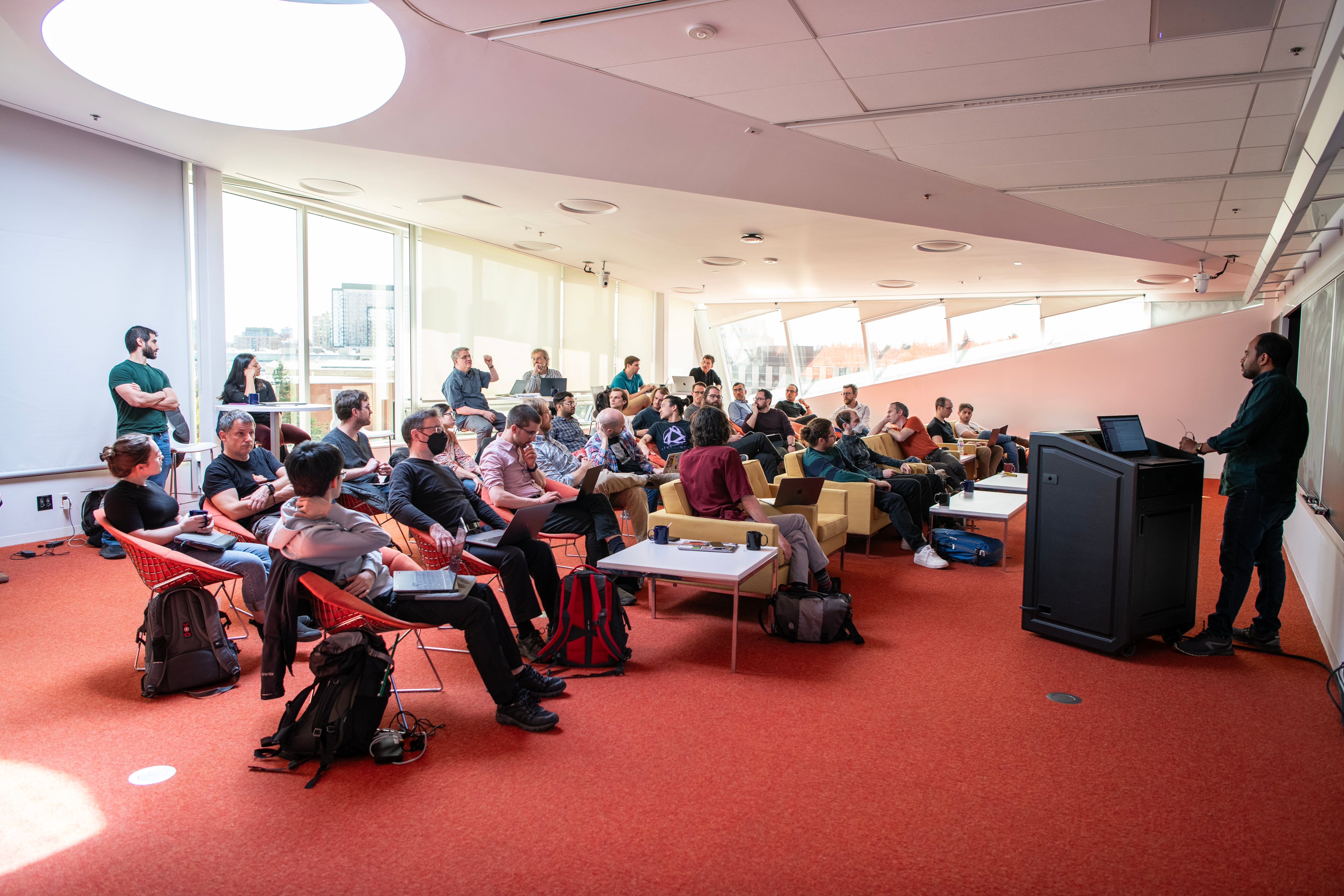Right now, off a secondary highway in British Columbia’s wine country, hundreds of steel piles are being driven into the ground. On each will sit a specialized radio dish pointing at the sky.
The array of dishes will be called the Canadian Hydrogen Observatory and Radio-transient Detector (CHORD), a next-generation radio instrument that will sit next to its predecessor, the Canadian Hydrogen Intensity Mapping Experiment (CHIME). Both are large collaborations between institutions across Canada. CHORD itself is being built with a grant from Canadian Foundation for Innovation awarded to Perimeter, McGill University, University of Calgary, and the University of Toronto, with additional funding from the Italian National Institute for Astrophysics and the National Research Council of Canada.
Here at Perimeter, a team of scientists that includes Kendrick Smith, Dustin Lang, Erik Schnetter, Seth Siegel, and Geoffrey Ryan are breaking new ground using CHIME and CHORD to understand mysterious intergalactic radio signals called Fast Radio Bursts, or FRBs.
Why CHIME leads the world in FRB detection
When FRBs were first discovered in 2007, they instantly caught the attention of astronomers. They are extremely brief radio signals, often as short as a millisecond. They’re powerful, too. The amount of energy they release averages what the sun produces in three days. Some repeat at regular intervals, some last longer than a millisecond.
“Fast radio bursts are a recently discovered phenomenon that we don't really understand,” says Smith, The Daniel Family James Peebles Chair in Theoretical Physics at Perimeter. Smith leads the team developing algorithms and software in CHIME and CHORD. “Very occasionally we see a giant pulse of radio waves from halfway across the observable universe. Explaining the origin of these pulses has become a central unsolved problem in astrophysics.”
More information is needed, which means we need to find more FRBs.
Since coming online in 2017, CHIME has proven remarkably good at finding FRBs. Before CHIME, we knew of about 10 FRBs. Then CHIME started finding a few every day. The reason? According to Smith, CHIME excels because of how much raw statistical data it collects.
Unlike a large dish which looks at a very small part of the sky, CHIME takes in as much of it as possible. It doesn’t look like a normal satellite dish. Instead, it’s essentially four immobile halfpipes that can look at a strip of sky from horizon to horizon, using the Earth’s rotation to take a large sweep of the sky every day.
With each sweep collecting so much data, researchers need software techniques to make that data usable.
“CHIME is an ambitious project to move difficulty from hardware to software. We’re trying to really push the envelope of what you can do with radio astronomy with a software-centric approach,” says Smith. “(CHIME’s) design is a compromise between optical focusing and software focusing. We have an array of antennas that sample all the radiation over a large collecting area. Then we can repeat the software focusing calculation on different parts of the sky and gain the statistical power of many telescopes pointing in slightly different directions. For many purposes, we're 100 times the statistical power of a single dish that’s the same size as CHIME.”
With the sheer amount of data CHIME collects, Smith wondered if there was a software solution for finding FRBs while avoiding interference from cell phones, planes flying overhead, and, notoriously, nearby microwave ovens.
Working with Perimeter computational scientist Dustin Lang, Smith and a team of students and researchers started writing code and custom software to separate the FRBs from the vast amount of data CHIME collected each day. Their work made CHIME the “world’s most powerful telescope for studying (FRBs),” according to Smith.
For their efforts, the many teams behind CHIME have won numerous awards, including the Canadian Governor General's Innovation Award, NSERC Brockhouse Canada Prize for Interdisciplinary Research, and, most recently, the Marcel Grossman Award.
Now, Smith, Lang, and their Perimeter colleagues are hoping CHORD will bring FRBs into sharper focus.
How CHORD will find more FRBs
Like its predecessor, CHORD mixes common, almost old-school technology with cutting-edge hardware and software innovations to gather an enormous amount of data each day. Smith estimates that CHORD will collect the same amount of data as the entire mobile network traffic of North America. Think about it: Every TikTok video, every email, every pdf menu you accidentally download when scanning a restaurant QR code. CHORD will collect the equivalent of all that data every day.
So how do they take that much data and find millisecond-long bursts of energy? By limiting interference at every single step.
Data collection starts with the 512 dishes sitting atop those steel piles. The dishes are made from fibreglass and a metal mesh that helps collect radiation while keeping costs low. Each dish houses a new type of feed developed by a team at the University of Toronto. They’re also quite deep to shield the inner array from noisy signals. “It’s a lesson we learned from CHIME,” says Lang. “The horizons are quite noisy, so we wanted to keep the dishes protected from unnecessary signals by making them deeper.”
The data collected from each dish eventually travels through three supercomputers, each tasked with filtering, organizing, and analyzing data in real time.
First, it heads to the F-Engine. The data travels through coax cables of the exact same length, which helps create a consistent feed of data to the computer no matter the weather or distance from the dish to the computer. The F-Engine then digitizes all the collected data and separates it into 6,000 channels. This helps researchers tune out polluted channels of data and tune into what they want to sort through, not unlike tuning through different radio stations.
The data then moves from the F-Engine to the second supercomputer, the X-Engine, via fibreoptic cables. The X-Engine correlates the data coming from each of the dishes. Since each dish collects slightly different information based on the exact direction of the FRB, the data needs to be correlated to make a cohesive signal. It’s almost like stacking a bunch of transparent images on top of each other and getting them to line up perfectly.
Having gone through the F-Engine and X-Engine, we’re finally able to start searching for FRBs using a third supercomputer. It’s here that Lang, Smith, and their team are coding algorithms to filter through all the remaining data in the hopes of finding FRBs. “Think of it like looking for a needle in a haystack. At first, it looks impossible because there are so many parameters you have to search over. But there are a lot of mathematical tricks you can use to search many possibilities at a time,” says Smith. “We built up a software framework and spent a lot of time looking at data, finding new filters and new logic to put into the system.”
Thanks to these powerful software solutions and CHORD’s expanded capabilities, the team is hoping to find answers to some remaining mysteries about FRBs, including their origins.
The next stage of FRB detection
CHORD will start its initial sweeps later this year after 64 dishes have been fabricated and set in place. Eventually, they will have all 512 operating together, along with two smaller sites in California and West Virginia to help triangulate where FRBs are coming from.
Smith says if you ask 10 astrophysicists about what FRBs are and where they come from, you’ll get 10 different answers.
“The evidence is pretty strong that FRBs are some sort of emission from magnetars, a particular type of neutron star that has a very high magnetic field,” Smith says. “But we don't yet understand the physics that leads to occasional supergiant pulses from magnetars.”
Lang is excited for the broader range of radio signals CHORD will detect compared to CHIME. CHORD will look at a band of 300-1500 MHz compared to CHIME’s 400-800 MHz. “With CHIME, we've seen that lots of FRBs are active in only just a small fraction of the band, some cover the whole band, and some have a huge variety,” he says. “So having that broader view will give us a handle on what this variety is like and how they work.”
CHORD won’t stop at FRBs, however. It will also help us detect new galaxies and map electrons throughout the universe. “Every time an FRB goes off, we learn a little bit about the distribution of electrons between us and the FRB,” Smith says. “If you have a lot of FRBs, you can make a statistical map of all the electrons in the universe.”
When asked what he’s most excited about for when CHORD starts collecting data, Smith quickly smiles. “CHORD is about a factor 10 more sensitive than CHIME, and there's a clear path to building telescopes even more powerful than CHORD. When you get big increases in sensitivity then we just don’t know what we might discover. FRBs, for example, were a surprise. CHORD is a step toward opening a new discovery space where we don’t know in advance what we’re going to learn.”
That sense of discovery certainly strikes a chord with us.
About PI
Perimeter Institute is the world’s largest research hub devoted to theoretical physics. The independent Institute was founded in 1999 to foster breakthroughs in the fundamental understanding of our universe, from the smallest particles to the entire cosmos. Research at Perimeter is motivated by the understanding that fundamental science advances human knowledge and catalyzes innovation, and that today’s theoretical physics is tomorrow’s technology. Located in the Region of Waterloo, the not-for-profit Institute is a unique public-private endeavour, including the Governments of Ontario and Canada, that enables cutting-edge research, trains the next generation of scientific pioneers, and shares the power of physics through award-winning educational outreach and public engagement.



